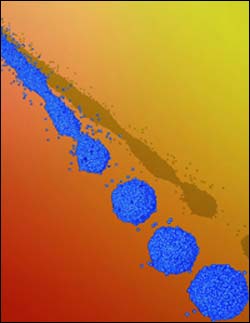Small is different

A computer simulation shows a jet of propane just six nanometers wide exiting a nozzle.
Computer sims vital tools in exploring nanoworld
Years ago, when Uzi Landman and his colleagues set out to uncover some of the rules that govern why a non-reactive metal like gold acts as a catalyst when it is in nanoclusters only a few atoms in size, they didn’t sit down in a lab with the precious metal. Instead, they ran computer simulations and discovered that gold is a very effective catalyst when it is in clusters of eight to two dozen atoms. They also found that electrical charging of gold is crucial to its catalytic capabilities. Six years later, the team has verified their earlier predictions experimentally, and they stand ready to further explore environmental effects on catalysis.
This practice of partnering computer simulations with real-world experiments is becoming more vital as scientists delve deeper into realms where the actors are measured on the nanoscale, Landman told a group of scientists Thursday, February 17 at the annual meeting of the American Association for the Advancement of Science (AAAS). “Small is different,” said Landman, director of the Center for Computational Materials Science and professor of physics at the Georgia Institute of Technology. “We cannot use the way physical systems behave on the large scale to predict what will happen when we go to levels only a few atoms in size. In this size regime, electrons transport electricity in a different way, crystallites have different mechanical properties and gold nanowires have strength twenty times larger than a big bar of gold, and inert metals may exhibit remarkable catalytic activity. But we know the rules of physics, and we can use them to create model environments in which we can discover new phenomena through high-level computer-based simulations.”
Computers are constantly becoming more powerful and capable of conducting more detailed explorations at the same time scientists across the globe are increasing their interest in the science of the small. The intersection of these two trends, said Landman, is allowing scientists to investigate realms that are too small for today’s technology to explore experimentally.
It’s not just a matter of making faster calculations, he said. “Experimentally, we can’t always go down to the resolution we need to see, explain and predict things, but with computer simulations we can go to any resolution we need,” said Landman. “Therefore, you can ask questions, deeper questions, on how materials behave on the small scale, even if you can’t get to that fine resolution experimentally.” This doesn’t mean that experiments aren’t necessary, said Landman. “It’s a supplementary and complimentary approach. The pillars of scientific methodology are composed now of experimentation, analytical theory and computer simulation.”
In addition to their work on nanocatalysis, Landman and colleagues have used simulations to explore other phenomena, such as the possibility of producing and maintaining a stable flow of liquid on the nanoscale. Their models predicted that it is possible to produce liquid jets only six nanometers wide. To date, in collaboration with Landman’s theory group, there are teams of engineers building nozzles that can produce jets in the 100 nanometer range. Within one year, said Landman, they expect to produce “nanojets” in the 10 nanometer range.
“The opportunity to make new discoveries in ways that weren’t possible before is an incredible gift and it has come about only because we can now simulate environments on the computer that are either not yet possible, too expensive or too dangerous to do in the lab,” said Landman. “We are now at a point in history where the science of the small holds the promise of producing a windfall of scientific discoveries. Computers serve tools for discovery in this exciting adventure.”
Media Contact
More Information:
http://www.icpa.gatech.eduAll latest news from the category: Physics and Astronomy
This area deals with the fundamental laws and building blocks of nature and how they interact, the properties and the behavior of matter, and research into space and time and their structures.
innovations-report provides in-depth reports and articles on subjects such as astrophysics, laser technologies, nuclear, quantum, particle and solid-state physics, nanotechnologies, planetary research and findings (Mars, Venus) and developments related to the Hubble Telescope.
Newest articles

Pinpointing hydrogen isotopes in titanium hydride nanofilms
Although it is the smallest and lightest atom, hydrogen can have a big impact by infiltrating other materials and affecting their properties, such as superconductivity and metal-insulator-transitions. Now, researchers from…

A new way of entangling light and sound
For a wide variety of emerging quantum technologies, such as secure quantum communications and quantum computing, quantum entanglement is a prerequisite. Scientists at the Max-Planck-Institute for the Science of Light…

Telescope for NASA’s Roman Mission complete, delivered to Goddard
NASA’s Nancy Grace Roman Space Telescope is one giant step closer to unlocking the mysteries of the universe. The mission has now received its final major delivery: the Optical Telescope…



